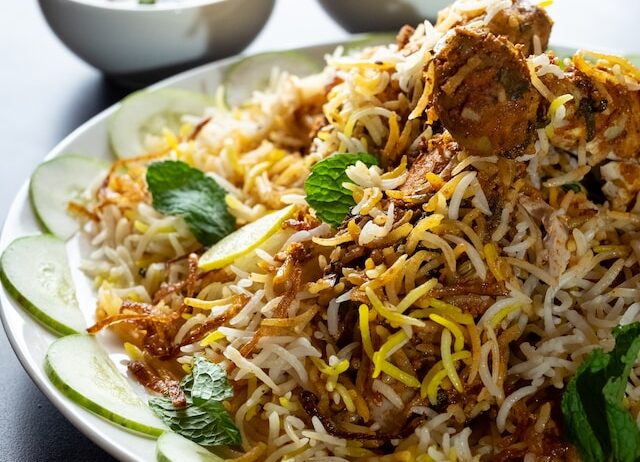Biryani is a dish that transcends borders and brings people together through its aromatic symphony of spices and perfectly cooked rice. This culinary masterpiece has a rich history, rooted in the royal kitchens of ancient India, and has since evolved into a beloved delicacy enjoyed by millions worldwide. In this article, we embark on a flavorful journey exploring the origins, diverse varieties, and the art of preparing the perfect biryani.
1. Origins and Evolution:
Biryani’s roots can be traced back to the Mughal era, when it was considered a luxurious dish fit for emperors and their courts. Over time, the recipe spread across the Indian subcontinent, adapting to regional tastes and preferences. Today, biryani comes in countless variations, each with its unique blend of spices, meats, and rice.
2. Regional Delights:
Explore the distinct biryani styles from different regions of India. The aromatic Lucknawi biryani with its tender meat and fragrant spices, the spicy Hyderabadi biryani layered with flavors, the Kolkata biryani with its subtle use of spices, and the Malabar biryani from the southern coast—all these variations showcase the diversity of this culinary gem.
3. Spice Symphony:
At the heart of biryani lies a symphony of spices that elevates it to unparalleled heights. Delve into the world of spices like cardamom, cloves, cinnamon, and saffron, each contributing its unique essence to the dish. Understanding the art of balancing these spices is crucial to creating the perfect biryani.
4. The Rice Conundrum:
The choice of rice can make or break a biryani. Basmati rice, known for its long grains and fragrant aroma, is the preferred choice. Learn about the importance of soaking, parboiling, and layering rice to achieve that fluffy and flavorful texture that defines a well-cooked biryani.
5. Meat Matters:
Whether it’s succulent chicken, tender mutton, or flavorful fish, the choice of meat is critical in biryani preparation. Each variety offers a unique taste profile, and the cooking time and spice combinations must be adjusted accordingly. Explore the nuances of meat selection for the perfect biryani experience.
6. Vegetarian Varieties:
For those who prefer plant-based delights, biryani has a lot to offer. From the aromatic vegetable biryani to the protein-packed soya biryani, vegetarians can indulge in the rich flavors and textures of this iconic dish.
7. Biryani Beyond Borders:
Discover how biryani has transcended its Indian origins and become a global sensation. From the Middle East to Southeast Asia and even finding its way into Western kitchens, biryani has left an indelible mark on the world culinary stage.
8. Home Cooking Tips:
Master the art of preparing biryani in the comfort of your own kitchen. From marinating meat to layering rice and achieving the perfect dum cooking technique, these step-by-step tips will help you create a biryani that rivals the best restaurants.
9. Biryani and Festivals:
Explore the cultural significance of biryani in various festivals and celebrations. Whether it’s Eid, Diwali, or a family gathering, biryani often takes center stage, symbolizing warmth, love, and the joy of shared meals.
10. The Future of Biryani:
As culinary trends evolve, biryani continues to adapt and reinvent itself. From fusion experiments to innovative twists on traditional recipes, the future promises exciting developments for biryani enthusiasts.
Conclusion:
Biryani, with its rich history, diverse regional variations, and the artistry involved in its preparation, stands as a testament to the culinary excellence of the Indian subcontinent. Whether you savor the traditional flavors or embark on a culinary adventure experimenting with new styles, biryani remains a dish that unites hearts and taste buds across the globe. So, the next time you indulge in a plate of biryani, savor not just the flavors but the centuries-old legacy that comes with every aromatic bite.
